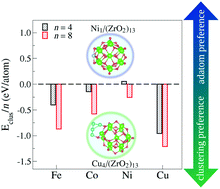当前位置:
X-MOL 学术
›
Phys. Chem. Chem. Phys.
›
论文详情
Our official English website, www.x-mol.net, welcomes your
feedback! (Note: you will need to create a separate account there.)
Ab initio investigation of the formation mechanism of nano-interfaces between 3d-late transition-metals and ZrO2 nanoclusters.
Physical Chemistry Chemical Physics ( IF 2.9 ) Pub Date : 2020-04-02 , DOI: 10.1039/d0cp00584c Larissa Zibordi-Besse 1 , Lucas G Verga 1 , Vivianne K Ocampo-Restrepo 1 , Juarez L F Da Silva 1
Physical Chemistry Chemical Physics ( IF 2.9 ) Pub Date : 2020-04-02 , DOI: 10.1039/d0cp00584c Larissa Zibordi-Besse 1 , Lucas G Verga 1 , Vivianne K Ocampo-Restrepo 1 , Juarez L F Da Silva 1
Affiliation

|
Understanding the formation of nano-interfaces between metallic clusters and nanoscale metal-oxides is an important step towards using such systems for catalytic applications. Thus, in this work, we employ density functional theory calculations to study the TMn-(ZrO2)13 interactions, for TM = Fe, Co, Ni, or Cu, and n = 1, 4, and 8. We found a general trend for adsorption and interaction energies (ad/int) for all cluster sizes, with . In terms of size effects, both adsorption and interaction (frozen adsorbed structures) energies become stronger with increasing cluster sizes due to the increase in the number of TM atoms in direct contact with the (ZrO2)13 nanocluster. The structural and electronic properties change for each TMn/(ZrO2)13 system, indicating that these properties could be tuned through variables like the TM species, cluster size and morphology (isomers with different structures). The results also indicate that, from the studied TMs, Ni (Cu) should form the smallest (largest) clusters when supported on the (ZrO2)13 nanoclusters. These and other results discussed here help understand the formation of the nano-interface in the TM-ZrO2 systems, which can be useful in the development of new catalysts.
中文翻译:

从头开始研究3d-晚期过渡金属与ZrO2纳米团簇之间的纳米界面形成机理。
了解金属簇和纳米级金属氧化物之间的纳米界面的形成是朝着将此类系统用于催化应用的重要一步。因此,在这项工作中,我们采用密度泛函理论计算来研究TMn-(ZrO2)13相互作用,其中TM = Fe,Co,Ni或Cu,并且n = 1、4和8。用于所有簇尺寸的吸附和相互作用能(ad / int),用。在尺寸效应方面,由于与(ZrO2)13纳米团簇直接接触的TM原子数量增加,随着团簇尺寸的增加,吸附和相互作用(冻结吸附的结构)能都变得更强。每个TMn /(ZrO2)13系统的结构和电子性质都会发生变化,表明可以通过诸如TM物种之类的变量来调节这些性质,簇的大小和形态(具有不同结构的异构体)。结果还表明,从研究的TM中,当(ZrO2)13纳米团簇上负载Ni(Cu)时应形成最小(最大)的团簇。本文讨论的这些结果和其他结果有助于理解TM-ZrO2系统中纳米界面的形成,这对开发新催化剂很有用。
更新日期:2020-04-15
中文翻译:

从头开始研究3d-晚期过渡金属与ZrO2纳米团簇之间的纳米界面形成机理。
了解金属簇和纳米级金属氧化物之间的纳米界面的形成是朝着将此类系统用于催化应用的重要一步。因此,在这项工作中,我们采用密度泛函理论计算来研究TMn-(ZrO2)13相互作用,其中TM = Fe,Co,Ni或Cu,并且n = 1、4和8。用于所有簇尺寸的吸附和相互作用能(ad / int),用。在尺寸效应方面,由于与(ZrO2)13纳米团簇直接接触的TM原子数量增加,随着团簇尺寸的增加,吸附和相互作用(冻结吸附的结构)能都变得更强。每个TMn /(ZrO2)13系统的结构和电子性质都会发生变化,表明可以通过诸如TM物种之类的变量来调节这些性质,簇的大小和形态(具有不同结构的异构体)。结果还表明,从研究的TM中,当(ZrO2)13纳米团簇上负载Ni(Cu)时应形成最小(最大)的团簇。本文讨论的这些结果和其他结果有助于理解TM-ZrO2系统中纳米界面的形成,这对开发新催化剂很有用。











































 京公网安备 11010802027423号
京公网安备 11010802027423号